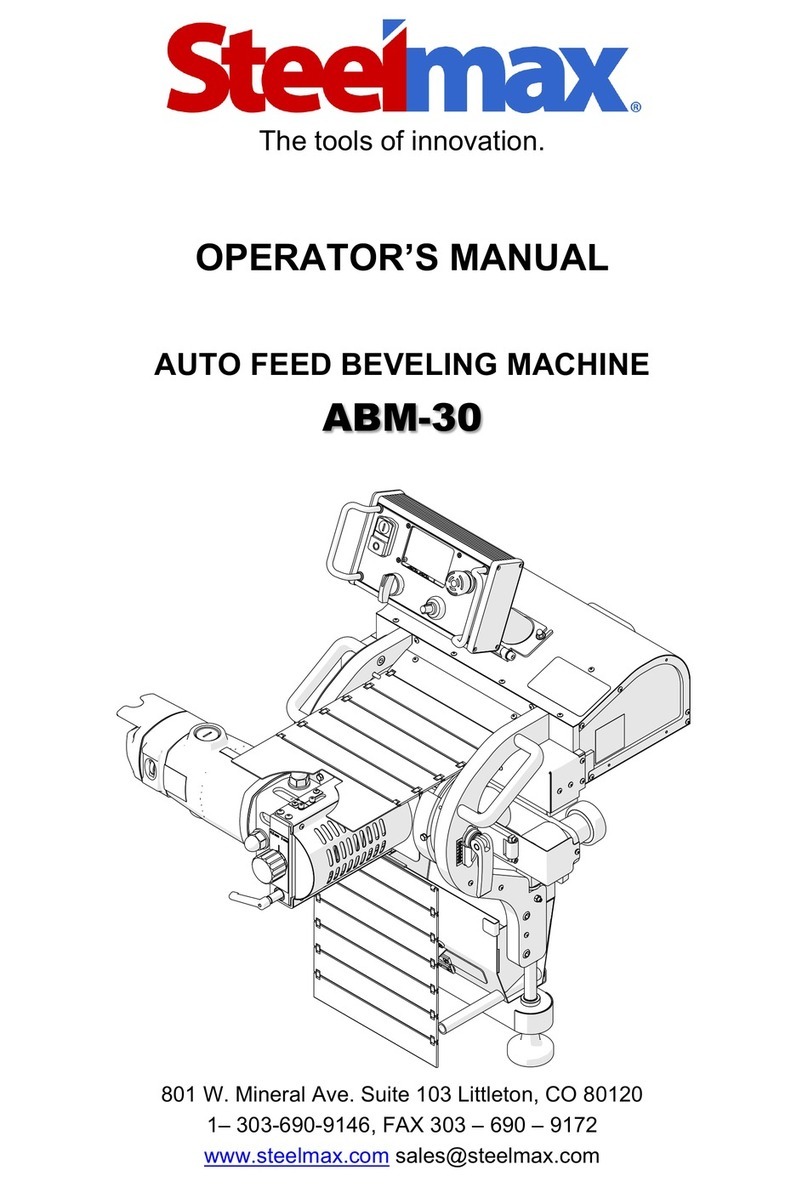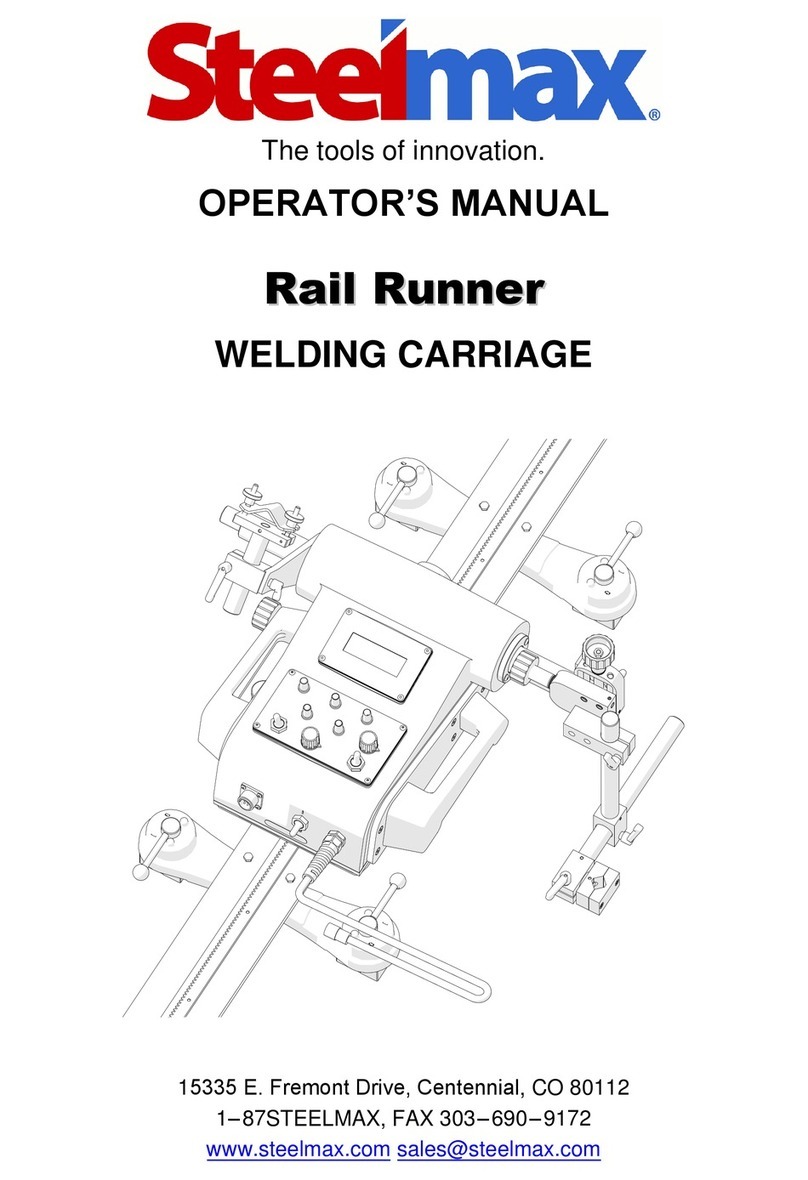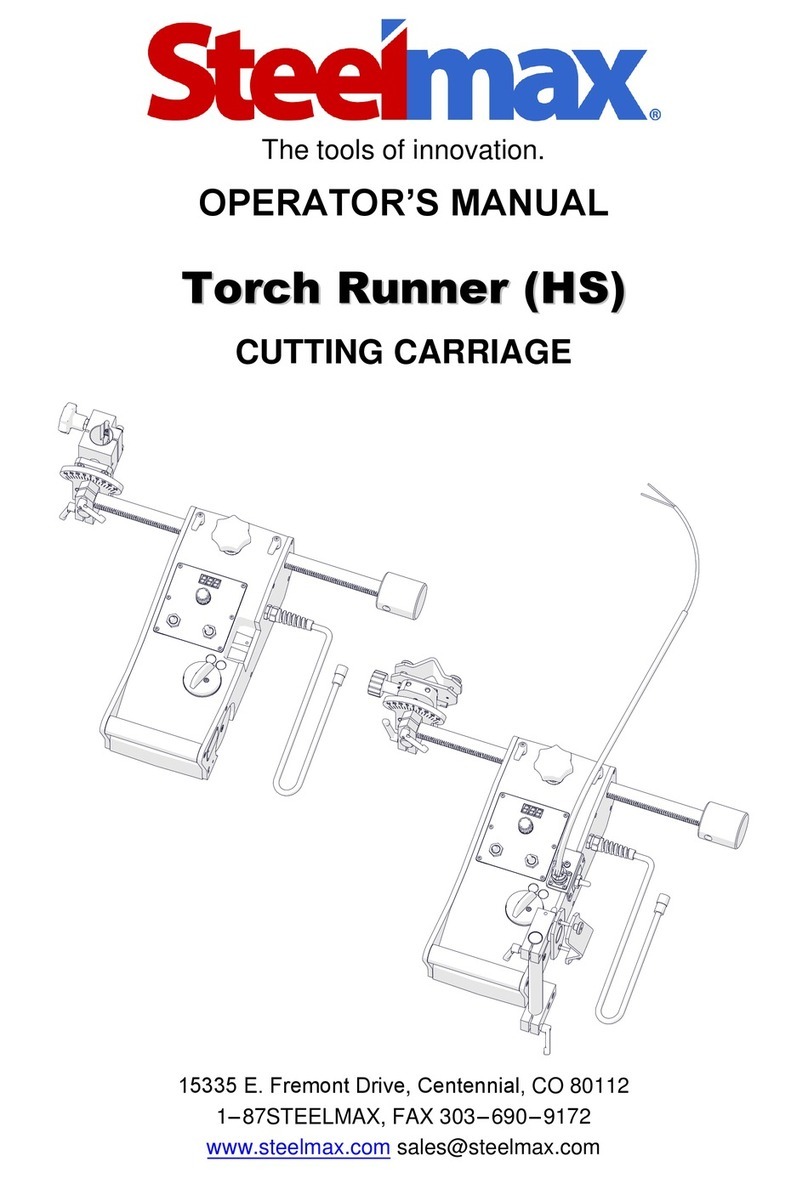SteelMax SBM-500 User manual

Contents
1. GENERAL INFORMATION............................................................................................... 3
1.1. Application................................................................................................................. 3
1.2. Technical data............................................................................................................ 3
1.3. Equipment included ................................................................................................... 4
1.4. Dimensions................................................................................................................ 5
1.5. Design ....................................................................................................................... 6
2. SAFETY PRECAUTIONS.................................................................................................. 7
3. STARTUP AND OPERATION........................................................................................... 9
3.1. Preparing................................................................................................................... 9
3.2. Setting the table and the feed unit.............................................................................12
3.3. Setting the bevel angle and milling head penetration ................................................13
3.4. Setting the feed wheel height....................................................................................17
3.5. Tilting the feed unit....................................................................................................18
3.6. Adjusting the feed wheel...........................................................................................19
3.7. Operating..................................................................................................................20
3.8. Removing and installing the milling head ..................................................................22
3.9. Replacing the cutting inserts.....................................................................................23
4. ACCESSORIES...............................................................................................................24
4.1. Pipe attachment........................................................................................................24
4.2. Cutting tools..............................................................................................................26
4.3. Table.........................................................................................................................27
4.4. Attachment for narrow plates ....................................................................................29
5. EXPLODED VIEWS AND PARTS LIST............................................................................31
6. DECLARATION OF CONFORMITY.................................................................................43
7. WARRANTY CARD..........................................................................................................44
APPENDIX –WIRING DIAGRAM

SBM-500
SBM-500 Operator’s Manual
3
1. GENERAL INFORMATION
1.1. Application
The SBM-500 is a stationary machine designed to bevel plates made of carbon steel,
stainless steel, or aluminum alloys. The workpieces can be machined at an angle of
15–60° and to the bevel width of up to 30 mm (1-3/16″).
Accessories allow beveling pipes with outer diameters of 50–150 mm (2–6″) and
beveling long plates and narrow plates.
1.2. Technical data
Voltage
3~ 480V + PE, 50/60 Hz
Power
8 kVA
Spindle rotational speed (without load)
500–2920 rpm
Feed wheel rotational speed
0.2–3.5 rpm
Feed speed
0.7–10.5 ft/min
Table load capacity
100 kg (220 lbs)
Bevel angle (ß, Fig. 1)
15–60°
Maximum bevel width (b, Fig. 1)
30 mm (1-3/16″)
Maximum milling head penetration (d, Fig. 1) allowed
per a single pass
4 mm (5/32″)
Workpiece thickness
3–100 mm (1/8–4″)
Minimum workpiece length
150 mm (6″)
Minimum workpiece width
50 mm (2″)
Protection level
IP 20
Protection class
I
Required ambient temperature
0–40°C (34–104°F)
Weight
865 kg (1910 lbs)
Fig. 1. Bevel dimensions; maximum bevel width depending on the angle
β
15°
30°
45°
60°
b
30 mm
30 mm
30 mm
30 mm

SBM-500
SBM-500 Operator’s Manual
4
1.3. Equipment included
1
Stationary bevelling machine (includes milling
head with 10 cutting inserts)
1 unit
2
Wooden box with base and mounting brackets
1 unit
3
Bevel height gauges
1 set
4
Tool box
1 unit
5
8 mm hex wrench
1 unit
6
6 mm hex wrench
1 unit
7
3.5 mm hex wrench
1 unit
8
14 mm combination wrench
1 unit
9
T15 torx screwdriver
1 unit
10
Grease for screws
1 unit
–
Operator’s manual
1 unit
3
6
4
1
2
5
7
8
9
10

SBM-500
SBM-500 Operator’s Manual
5
1.4. Dimensions
1276 mm (50″)
1675 mm (66″)
1216 mm (48″)
910 mm (36″)

SBM-500
SBM-500 Operator’s Manual
6
1.5. Design
Collision prevention
Bevel angle
adjustment unit
Chip container
Table
Feed unit
Milling unit
Control cabinet
Milling head penetration
adjustment unit

SBM-500
SBM-500 Operator’s Manual
7
2. SAFETY PRECAUTIONS
1. Before use, read this Operator’s Manual and complete a training in occupational
safety and health.
2. Use only in applications specified in this Operator’s Manual.
3. Make sure that the machine has all parts and they are genuine and not damaged.
4. Make sure that the specifications of the power source are the same as those
specified on the rating plate.
5. Connect the machine to a 3×480 V + PE power source. Protect the power source
with a 25 A three-phase slow-blow fuse. If you use a residual-current circuit
breaker, it must be of type B and of value of at least 300 mA.
6. Do not pull the cord. This can cause damage and electric shock.
7. Keep the machine in vertical position during transport and work.
8. Put the machine on a surface that ensures balance and efficiently transfers the
loads of the machine and workpiece. An incorrectly prepared surface may lead to
damage, incorrect machine work, and injuries to persons nearby.
9. Keep untrained bystanders away from the machine.
10. Before each use, ensure the correct condition of the machine, power source,
power cord, plug, control panel, and tools.
11. Before each use, make sure that no part is cracked or loose. Make sure to
maintain correct conditions that can have an effect on the operation of the
machine.
12. After the power is off, wait 3 minutes before you open the control cabinet.
13. After the power is off, wait 60 seconds before you turn the power on again.
14. Keep the machine dry. Do not expose the machine to rain, snow, or frost.
15. Keep the worksite well-lit, clean, and free of obstacles.
16. Make sure that the cutting inserts and the milling head are correctly attached.
Remove wrenches from the worksite before you connect the machine to the
power source.
17. Do not use tools that are dull or damaged.
18. If the cutting edge of an insert is worn, rotate all inserts by 90°. If all edges are
worn, install new inserts specified in this Operator’s Manual.
19. Do not make bevels or use workpieces whose parameters differ from those
specified in the technical data.

SBM-500
SBM-500 Operator’s Manual
8
20. Do not use near flammable materials or in explosive environments.
21. Always use the feed wheel during work.
22. Use eye protection, ear protection, gloves, and protective clothing. Do not use
loose clothing.
23. Do not touch chips or moving parts. Do not let anything catch in moving parts.
Do not put hands under the feed wheel.
24. After each use, clean the machine and the milling head with a cotton cloth and no
chemical agents. Do not remove chips with bare hands.
25. Maintain the machine and install/remove parts and tools only after you unplug the
machine from the power source.
26. Repair only in a service center appointed by the seller.
27. If the machine is wet or has any damage, stop the work and promptly send the
machine to the service center for check and repair.
28. Do not leave the machine when it operates.
29. If you are not going to use the machine for an extended period, put anti-corrosion
material on the steel parts.

SBM-500
SBM-500 Operator’s Manual
9
3. STARTUP AND OPERATION
3.1. Preparing
Use the 6 mm hex wrench to tighten the handle (1, Fig. 2). Then, use the 8 mm hex
wrench to detach the machine from the brackets (2).
Fig. 2. Installing the handle and detaching the machine from the base
1
2

SBM-500
SBM-500 Operator’s Manual
10
Use a pallet jack to lift the machine from left or right (Fig. 3), and then transport it to
the worksite.
Fig. 3. Transporting the machine to the worksite

SBM-500
SBM-500 Operator’s Manual
11
Put the machine on a surface that ensures balance and efficiently transfers the loads
of the machine and workpiece. Rotate the feet that are not in contact with the surface
so that they rest on it (1, Fig. 4). Then, use the 18 mm flat wrench to tighten the nuts,
which will lock the feet in this position.
Fig. 4. Levelling the machine on the surface
1
2

SBM-500
SBM-500 Operator’s Manual
12
3.2. Setting the table and the feed unit
Move the table forward so that it makes contact with the bolt (1, Fig. 5), and then use
the lever (2) to lock the table in this position. Next, use the handle (3) to rotate the
feed unit so that the screw makes contact with the bumper (4).
Fig. 5. Moving the table and lowering the feed unit
4
1
2
3

SBM-500
SBM-500 Operator’s Manual
13
3.3. Setting the bevel angle and milling head penetration
First, set the penetration of the milling head to zero. If there is a gap between the
vertical base (1)and horizontal base (2, Fig. 6a), unlock the lever (3). Then, rotate
the knob (4) so that the vertical base comes in contact with the horizontal base
(Fig. 6b). Lock the lever in this position.
Fig. 6. Setting the milling head penetration to zero: incorrect (a), correct (b)
1
3
4
a)
b)
CORRECT
✓
INCORRECT
2

SBM-500
SBM-500 Operator’s Manual
14
To set the bevel angle (Fig. 7), unlock the levers (1). Then, use the crank (2) to rotate
the milling unit so that the scale (3) shows the required angle. Lock the levers in this
position.
Fig. 7. Setting the bevel angle
Before the first pass, move the vertical base (1) away from horizontal base (2, Fig. 8).
To do this, unlock the lever (3), and then use the knob (4) to move the vertical base
to a gap (X) that is correct for a single pass.
1
1
2
3
15° is set
45° is set

SBM-500
SBM-500 Operator’s Manual
15
β
15°
20°
25°
30°
35°
40°
45°
50°
55°
60°
Maximum allowed gap X [mm]
30
a [mm]
4 passes
29
28
27
15.6
26
15.0
25
17.5
14.4
24
20.1
16.8
13.9
3 passes
23
19.3
16.1
13.3
22
22
18.5
15.4
12.7
21
21
17.6
14.7
12.1
20
23.8
20
16.8
14.0
11.6
19
22.6
19
15.9
13.3
11.0
18
25.7
21.5
18
15.1
12.6
10.4
17
24.3
20.3
17
14.3
11.9
9.8
16
27.7
22.9
19.1
16
13.4
11.2
9.2
2 passes
15
26.0
21.4
17.9
15
12.6
10.5
8.7
14
30.0
24.3
20.0
16.7
14
11.8
9.8
8.1
13
27.9
22.5
18.6
15.5
13
10.9
9.1
7.5
12
25.7
20.8
17.1
14.3
12
10.1
8.4
6.9
11
30.2
23.6
19.0
15.7
13.1
11
9.2
7.7
6.4
10
27.5
21.5
17.3
14.3
11.9
10
8.4
7.0
5.8
9
33.6
24.7
19.3
15.6
12.9
10.7
9
7.6
6.3
5.2
8
29.9
22.0
17.2
13.9
11.4
9.5
8
6.7
5.6
4.6
1 pass
7
26.1
19.2
15.0
12.1
10.0
8.3
7
5.9
4.9
4.0
6
22.4
16.5
12.9
10.4
8.6
7.2
6
5.0
4.2
3.5
5
18.7
13.7
10.7
8.7
7.1
6.0
5
4.2
3.5
2.9
4
14.9
11.0
8.6
6.9
5.7
4.8
4
3.4
2.8
2.3
3
11.2
8.2
6.4
5.2
4.3
3.6
3
2.5
2.1
1.7
2
7.5
5.5
4.3
3.5
2.9
2.4
2
1.7
1.4
1.2
1
3.7
2.8
2.1
1.7
1.4
1.2
1
0.8
0.7
0.6

SBM-500
SBM-500 Operator’s Manual
16
Between the vertical base and the horizontal base, put the bevel height gauge that
matches the angle. On the scale (5), read the bevel height ‘a’ for the gap. Make sure
that the vertical base is not in contact with the milling head, and then lock the lever in
this position.
If the vertical base is moved away too far, it may come in contact with
the milling head and thus damage the machine. Do not exceed 4 mm
(5/32″) of the milling head penetration ‘d’ (Fig. 8) per a single pass. The table
shows how far you can move the vertical base per a single pass not to exceed
the penetration ‘d’ of 4 mm.
Fig. 8. Setting the milling head penetration before the first pass
Angle
15°
20°
25°
30°
35°
40°
45°
50°
55°
60°
Maximum allowed gap-increase
per a single pass
[mm]
4
4
5
5
5
5
6
6
7
8
1
2
3
4
5

SBM-500
SBM-500 Operator’s Manual
17
3.4. Setting the feed wheel height
Use the knob (1, Fig. 9) to set the feed wheel at such a height so that the workpiece
is firmly pressed to the horizontal base (2) during rotation of the feed wheel. Then,
use the nut (3) to lock the knob in this position.
Fig. 9. Setting the feed wheel height
3
1
2
2
3

SBM-500
SBM-500 Operator’s Manual
18
3.5. Tilting the feed unit
To ensure that the workpiece is sufficiently pressed to the vertical base, use the
knobs (1, 2, Fig. 10) to tilt the feed unit. Do this when milling narrow workpieces or
after moving the vertical base away from the horizontal base.
Fig. 10. Tilting the feed unit
Then, adjust the feed wheel.
1
2

SBM-500
SBM-500 Operator’s Manual
19
3.6. Adjusting the feed wheel
Loosen the knob (1, Fig. 11) and lever (2). Then, use the knobs (3) and (4) to move
the feed unit so that (5) the wheel comes as close to the milling spot as possible (6).
Next, lock the knob (1) and lever (2) in this position. Do not let the feed wheel or its
cover come in contact with the milling head or vertical base.
Fig. 11. Adjusting the feed wheel
Use the
knob 3
Use the
knob 4
2
5
6
4
3
1

SBM-500
SBM-500 Operator’s Manual
20
3.7. Operating
Connect the machine to the power source and use the switch (1, Fig. 12) to turn on
the power. On the control panel, press START, and then start the SPINDLE and
FEED. Use knobs to set the required spindle speed and feed speed. Next, loosen the
knob (2, Fig. 12), lower the chip guard (3), and then tighten the knob in this position.
Fig. 12. Starting the work
Put the workpiece on the right side. Press the workpiece to the vertical and
horizontal base and move it to the direction (4, Fig. 12) to put it under the feed wheel.
After the first pass, move the vertical base away to get the correct gap for the next
pass. Between the vertical base and the horizontal base, put the bevel height gauge
related to the angle. On the gauge scale, read the bevel height related to the gap.
Make sure that the vertical base is not in contact with the milling head.
1
2
3
5
4
Table of contents
Other SteelMax Industrial Equipment manuals
























